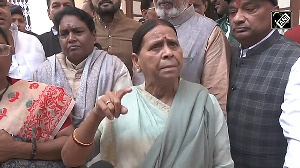The number of road accidents in India is three times higher than that prevailing in developed countries: 35 for 1,000 vehicles while the figure ranges from 4 to 10 in developed countries. Consequently, the motor accident tribunals are jammed with claim petitions.
The Motor Vehicles Act enjoins the tribunals to grant a just and fair amount of compensation to the victims of mishaps. However, arriving at an equitable figure has not been easy for the courts.
In recent weeks, the Supreme Court delivered two judgements in which the amount of compensation to the widows was reduced on the ground that the courts below had not followed the correct formula (Uttaranchal Transport vs Vimla Devi; Bangalore Transport vs Padma).
In both cases, the widows of the accident victims had abandoned the long and tedious legal battle midway, leaving it to the courts to arrive at an equitable amount.
The Supreme Court acknowledged the problem in a 1991 judgement ('Susamma Thomas') thus: "The assessment of damages to compensate the dependents is beset with difficulties because from the nature of things, it has to take into account many imponderable, e.g., the life expectancy of the deceased and the dependents, the amount that the deceased would have earned during the remainder of his life, the amount that he would have contributed to the dependents during that period, the chances that the deceased may not have lived or the dependents may not live up to the estimated remaining period of their life expectancy, the chances that the deceased might have got better employment or income or might have lost his employment or income altogether."
The manner of arriving at the damages followed by the courts is to ascertain the net income of the deceased available for the support of himself and his dependents, and to deduct from it such part of his income as the deceased was accustomed to spend upon himself, as regards both self-maintenance and pleasure, and to ascertain what part of his net income the deceased was accustomed to spend for the benefit of the dependents.
Then that should be capitalised by multiplying it by a figure representing the proper number of year's purchase. This is called the 'multiplier' in legal parlance.
"Much of the calculation necessarily remains in the realm of hypothesis and in that region arithmetic is a good servant but a bad master since there are so often many imponderables. In every case it is the overall picture that matters", and the court must try to assess as best as it can the loss suffered.
Since the approach of the courts was divergent, an amendment was made in 1994 to the Act with a schedule to calculate the compensation in a more tangible way. However, the draftsmen were bad mathematicians and the Supreme Court found the schedule full of defects.
In UP Transport Corporation vs Trilok Chand, the Supreme Court listed some of the faults and later judgements found more. The Trilok Chand judgement said in 1996: "In item No.1 for a victim aged 15 years, the multiplier is shown to be 15 years and the multiplicand is shown be Rs 3,000.
"The total should be 3,000 X 15 = 45,000 but the same is worked out at Rs 60,000. Similarly, in the second item the multiplier is 16 and the annual income is Rs 9,000; the total should have been Rs 1,44,000 but is shown to be Rs 1,71,000.
To put it briefly, the table abounds in such mistakes. Neither the tribunals nor the courts can go by the ready reckoner. It can only be used as a guide."
Apart from bad arithmetic, the schedule has not been updated since 1994 despite the rise in cost of living. Section 163A provides for such an amendment but no lawmaker has taken a second look at the compensation figures.
Moreover, the multiplier formula was evolved when the life expectancy of an average Indian was presumed to be 60 years or less. Now it has gone up and correspondingly, the working years also have also stretched substantially.
Meanwhile, in the US , where ambulance-chasers invent new grounds for boosting compensation figures, they have pressed for 'hedonistic' damages - the loss of enjoyment of life in terms of dollars. The insurers call it predatory damages. In this country, the schedule has been a boon for the insurance companies.
Though the Supreme Court has practically condemned the schedule, the judiciary has been following it inadvertently all these years.
Even the Supreme Court has followed the formula in many cases, as the ones delivered recently. Like religious laws, if a bad rule is trusted long enough, the judiciary, the law-makers and the people will find merit in it.






 © 2025
© 2025